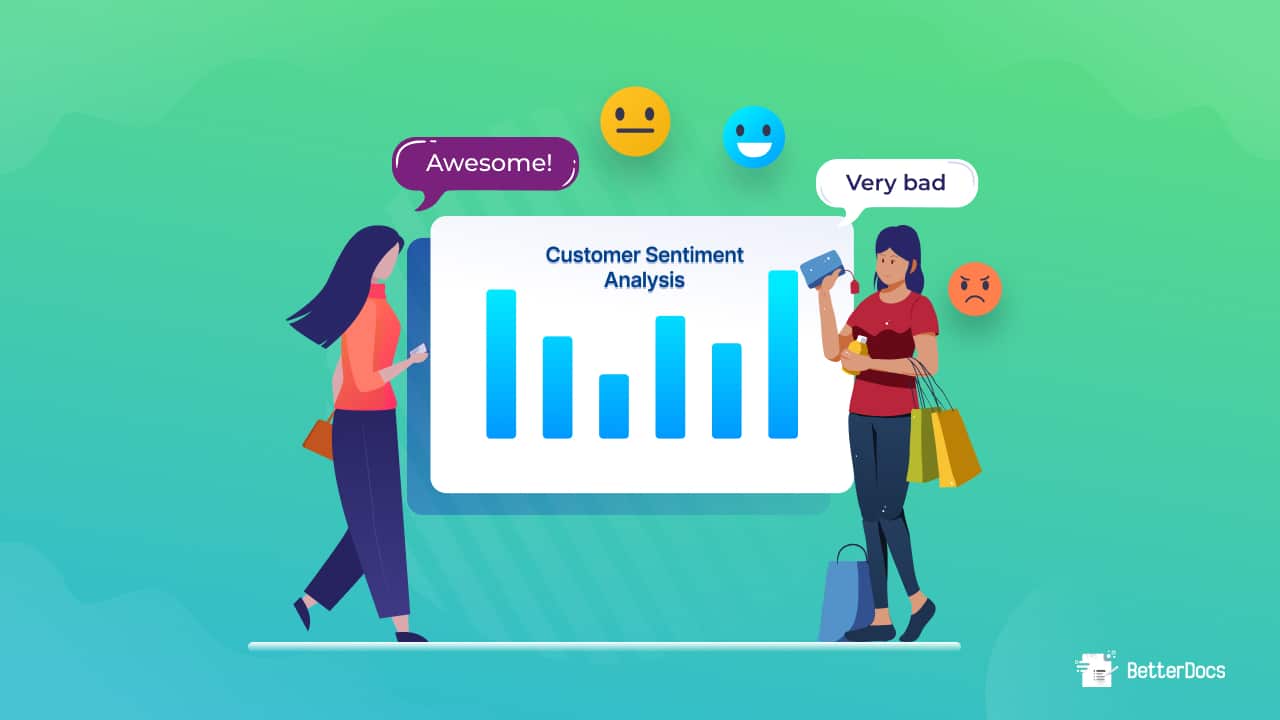To get deeper insights into customer expectations, needs, & preferences, analyzing customer sentiment is important. Analyzing customer sentiment is considered an essential tool for businesses looking to get a better understanding of their customers and take measures accordingly to improve customer experience. Today, in this blog, you are going to learn about customer sentiment analysis and why it is important for your business.

What Is Customer Sentiment Analysis & How Does It Work?
If you want to meet your customer’s needs and expectations better, you should prioritize knowing customer sentiment, and for that, you need to analyze customer sentiment first. Customer sentiment analysis is the automated process through which customers’ opinions, emotions, and attitudes are measured toward a business, company, product, or service. And no matter if you are a marketer, product manager, or customer service representative, understanding customer sentiment is crucial for you. This will help you to achieve your business goals.
The primary objective of analyzing customer sentiment is to have an understanding of customers’ perceptions of a business or its offerings. This help businesses understand what aspects of their service are working well, customers’ likes and dislikes, and where improvements can be made. By doing so, businesses can make data-driven and effective decisions that help strengthen customer satisfaction, loyalty, and retention. They can also enhance their products and services based on what customer expects.
How how is it carried out? Natural language processing (NLP) and machine learning techniques are used in this analysis to automatically identify and extract sentiments, opinions, and emotions expressed by customers. Online reviews, social media posts, feedback surveys, and other sources of customer feedback are used to measure it.
Customer sentiment analysis algorithms often use polarity and magnitude as key parameters to analyze and categorize customer communications.
Polarity refers to the overall emotional tone of the message and is typically categorized as positive, negative, or neutral. For example, a customer’s message that expresses satisfaction with a product or service would be considered positive, while a message expressing dissatisfaction or disappointment would be considered negative.
Magnitude, on the other hand, measures the strength or intensity of the emotion conveyed in the message. This could be a measure of how strongly positive or negative the sentiment is, or it could be an indication of the degree of emotion conveyed in the message, regardless of whether it is positive or negative.
Both polarity and magnitude can be useful in helping businesses to better understand customer feedback and to identify areas for improvement in their products or services.

Types Of Customer Sentiment Analysis That Businesses Use
There are several types of customer sentiment analysis techniques that businesses can use to gain insights from customer feedback. Below are the types of customer sentiment analysis:
Fine-Grained Sentiment Analysis
This technique determines the polarity score of words in a text to determine sentiment. Each word is assigned a polarity value ranging from highly positive to very negative, and the aggregate of these scores is used to calculate the overall sentiment of the text. Fine-grained customer sentiment analysis is beneficial for finding specific positive or negative characteristics of a product or service and understanding the intricacies of client sentiment.
Emotion Detection
Emotion detection identifies and evaluates customers’ emotions and moods within the text. While fine-grained analysis determines whether a consumer appears positive or negative, emotion detection goes a step further by labeling specific emotions such as happiness, anger, sadness, or fear. This technique is very beneficial for determining a product’s or service’s emotional impact on the client.
Aspect-Based Sentiment Analysis
Aspect-based customer sentiment analysis technique breaks text into parts, such as phrases, sentences, and tokens, and measures the accompanying sentiment. It enables organizations to examine customer feedback on specific features, usability, or different aspects of customer support of a product or service. Aspect-based sentiment analysis can provide more granular insights into a product’s or service’s strengths and faults.
Why Is It Important To Understand Customer Sentiment?
By now, you must have gotten an idea about what is customer sentiment analysis. Incorporating such analyses into their strategies helps businesses make more informed decisions that lead to better outcomes for both the business and the customer.
Helps Understand Customer Needs & Preferences
For any business, there’s no alternative to understanding customer preferences and strategizing accordingly. Without having proper knowledge of your customer’s needs and expectations, you can’t make the right decisions at the right time.
Businesses can identify key themes and trends in customer feedback, providing valuable insights into customer expectations. This data can then be used to improve products and services, ultimately increasing customer satisfaction and loyalty. Therefore, to understand your customers, you need to conduct customer sentiment analysis.
Aids In Identifying Areas For Improvement
Through analyzing customer sentiment, businesses can identify where they need to make improvements. This allows them to take necessary actions based on customer reviews and opinions. For example, if a large number of customers express dissatisfaction with a particular aspect of a product or service, such as poor customer service, businesses can use this information to improve and address the issue. Or, there might be feature requests for particular products or services that businesses might consider incorporating into their strategies. Thus, by analyzing customer sentiment, they can measure where they may be falling short of meeting customer expectations.
Helps Strengthen Customer Relationships & Loyalty
Even when you want to build a strong relationship with your customers, analyzing customer sentiment is what you should keep in consideration. As we have just explained, analyzing customer sentiment helps you to meet customers’ expectations better; this, in turn, helps you to form a better and long-term relationship with them and increase customers.
Businesses can demonstrate that they value their customer’s opinions and are committed to providing a positive customer experience by listening to and responding to their feedback, requests, and queries. This can help to foster trust and encourage customers to stick with the brand over time.

How To Conduct Customer Sentiment Analysis Effectively?
Now that you know the importance of analyzing customer sentiment, you must be thinking about how to conduct customer sentiment analysis effectively. So, we are here with a comprehensive guide on how to analyze customer sentiment efficiently.
Ask For Customer Reviews & Feedback
The first and most important thing that you should prioritize while doing customer sentiment analysis is to collect customer reviews and know customer opinions. Customer reviews are the statements that best reflect how your product or service is doing. It is a certification of how your customers feel about what you offer them. So, knowing customer opinions and getting their feedback will help you analyze their sentiment better. In this way, you will be able to take address the lackings and take actions accordingly to improve your product or service.
Monitor Customer Service Calls & Messages
You should not overlook the calls and messages that your customer service representatives get. As a business owner, you must know what your customers are expecting and experiencing from your service. And customer service calls & messages will help you with that.
By thoroughly monitoring the calls and messages, you will be able to better understand the issues your customers are facing, how they are feeling about your service, if there is something more customers are expecting from your team, and how you can improve your brand image.

Measure Customer Sentiment Through Social Media
Because the majority of people use social media platforms such as Facebook, Instagram, and Twitter to express their thoughts and feelings, these platforms have become valuable resources for gathering customer data as well in this modern era. Businesses can gain a better understanding of their customer’s perceptions of their brand by monitoring brand mentions on social media.
Customers are known to use a variety of positive and negative words in their online conversations, such as “excellent,” “awful,” or “hate,” which can provide valuable insights into their attitudes toward a brand.
These platforms’ social media Application Programming Interfaces (APIs) can be used to collect this data. These APIs enable businesses to gain real-time and historical brand mention data, providing a comprehensive picture of how customers interact with their brand. Businesses can gain a competitive advantage by leveraging the power of social media to stay on top of customer sentiment and make informed decisions based on their insights.
Conduct Online Surveys To Understand Customer Sentiment
Another way to do effective customer sentiment analysis is to conduct online surveys. One of the primary advantages of online surveys is that they enable businesses to ask specific questions designed to elicit customer attitudes and opinions. This data can then be used to help shape product development, marketing strategies, and customer service initiatives.

Online surveys enable businesses to collect data from a diverse range of customers across different geographies and demographics, in addition to providing valuable insights into customer sentiment. This enables businesses to identify patterns and trends in customer sentiment that would otherwise be invisible via other channels.
Implement AI To Analyze Customer Sentiment
In today’s data-driven business environment, implementing artificial intelligence (AI) in analyzing customer sentiment is advantageous. To identify patterns and trends in customer sentiment, AI algorithms can analyze massive amounts of data, such as customer feedback, social media conversations, and online reviews.
The ability of AI to process unstructured data is one of the primary benefits of using it in customer sentiment analysis. In contrast to traditional sentiment analysis methods that rely on structured data, AI algorithms can analyze unstructured data such as text and voice recordings, providing a more complete picture of customer sentiment.
Another benefit of using artificial intelligence in customer sentiment analysis is its ability to learn and adapt over time. AI algorithms can improve their accuracy and provide businesses with more valuable insights into customer sentiment by continuously analyzing data.
Connect With The Customers Personally
To understand your customer’s sentiments and analyze them you should consider connecting with your customers personally. Knowing about your customers’ problems, issues, experiences, and expectations helps you to build strong relationships with your customers. You can evaluate these better when you connect with them personally. This makes your customers feel closer to your business and enhances customer trust.
Analyze Customer Sentiment & Improve Your Customer’s Experience
Analyzing customer sentiment is no longer an optional thing but an essential part of your business strategy. It has become a must-do for your business if you want to enhance your customer experience. Therefore, you should leave no stone unturned to understand your customer sentiment and analyze customer sentiment properly.
Was this blog helpful for you? Feel free to share your thoughts and join our Facebook Community to stay connected. And if you want to get more blogs like this, subscribe to our blogs and learn more about effective customer service.
![5+ Knowledge Base Challenges You Should Look Out for in 2026 [With Solutions]](https://betterdocs.co/wp-content/uploads/2025/12/1280x720-_-Blog-Banner-_-Knowledge-Base-Challenges-1-1024x576.jpg)





